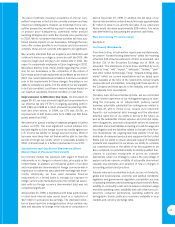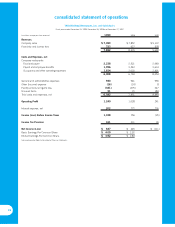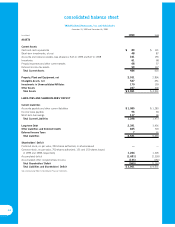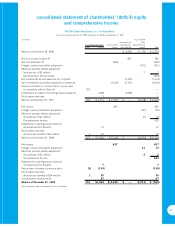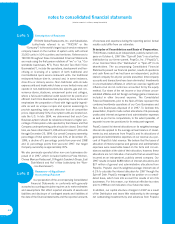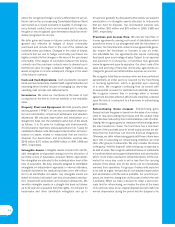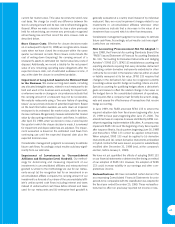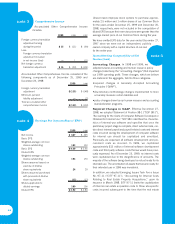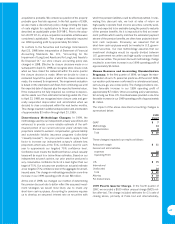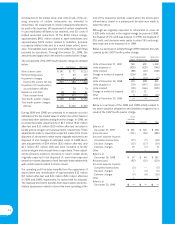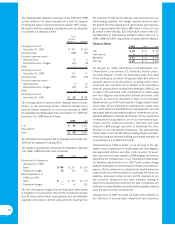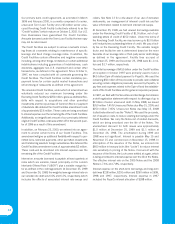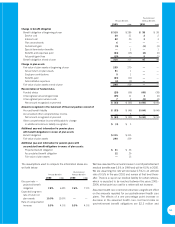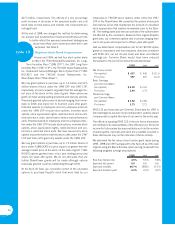Pizza Hut 1999 Annual Report Download - page 49
Download and view the complete annual report
Please find page 49 of the 1999 Pizza Hut annual report below. You can navigate through the pages in the report by either clicking on the pages listed below, or by using the keyword search tool below to find specific information within the annual report.
47
acquisition is probable. We consider acquisition of the property
probable upon final site approval. In the first quarter of 1999,
we also made a discretionary policy change limiting the types
of costs eligible for capitalization to those direct cost types
described as capitalizable under SOP 98-1. Prior to the adop-
tion of EITF 97-11, all pre-acquisition real estate activities were
considered capitalizable. This change unfavorably impacted
our 1999 operating profit by approximately $3 million.
To conform to the Securities and Exchange Commission’s
April 23, 1998 letter interpretation of Statement of Financial
Accounting Standards No. 121, “Accounting for the
Impairment of Long-Lived Assets and for Long-Lived Assets to
Be Disposed Of,” our store closure accounting policy was
changed in 1998. Effective for closure decisions made on or
subsequent to April 23, 1998, we recognize store closure costs
when we have closed the restaurant within the same quarter
the closure decision is made. When we decide to close a
restaurant beyond the quarter in which the closure decision is
made, it is reviewed for impairment. The impairment evaluation
is based on the estimated cash flows from continuing use until
the expected date of disposal plus the expected terminal value.
If the restaurant is not fully impaired, we continue to depreci-
ate the assets over their estimated remaining useful life. Prior
to April 23, 1998, we recognized store closure costs and gen-
erally suspended depreciation and amortization when we
decided to close a restaurant within the next twelve months.
This change resulted in additional depreciation and amortization
of approximately $3 million through April 23, 1999.
Discretionary Methodology Changes. In 1999, the
methodology used by our independent actuary was refined and
enhanced to provide a more reliable estimate of the self-
insured portion of our current and prior years’ ultimate loss
projections related to workers’ compensation, general liability
and automobile liability insurance programs (collectively
“casualty loss(es)”). Our prior practice was to apply a fixed
factor to increase our independent actuary’s ultimate loss
projections which was at the 51% confidence level for each
year to approximate our targeted 75% confidence level.
Confidence level means the likelihood that our actual casualty
losses will be equal to or below those estimates. Based on our
independent actuary’s opinion, our prior practice produced a
very conservative confidence factor at a level higher than our
target of 75%. Our actuary now provides an actuarial estimate
at our targeted 75% confidence level in the aggregate for all self-
insured years. The change in methodology resulted in a one-time
increase in our 1999 operating profit of over $8 million.
At the end of 1998, we changed our method of determining
the pension discount rate to better reflect the assumed invest-
ment strategies we would most likely use to invest any
short-term cash surpluses. Accounting for pensions requires
us to develop an assumed interest rate on securities with
which the pension liabilities could be effectively settled. In esti-
mating this discount rate, we look at rates of return on
high-quality corporate fixed income securities currently avail-
able and expected to be available during the period to maturity
of the pension benefits. As it is impractical to find an invest-
ment portfolio which exactly matches the estimated payment
stream of the pension benefits, we often have projected short-
term cash surpluses. Previously, we assumed that all
short-term cash surpluses would be invested in U.S. govern-
ment securities. Our new methodology assumes that our
investment strategies would be equally divided between
U.S. government securities and high-quality corporate fixed
income securities. The pension discount methodology change
resulted in a one-time increase in our 1999 operating profit of
approximately $6 million.
Human Resource and Accounting Standardization
Programs. In the first quarter of 1999, we began the stan-
dardization of our U.S. personnel practices. At the end of 1999,
our vacation policies were conformed to a calendar-year based,
earn-as-you-go, use-or-lose policy. The change provided a one-
time favorable increase in our 1999 operating profit of
approximately $7 million. Other accounting policy standardiza-
tion among our three U.S. Core Businesses provided a one-time
favorable increase in our 1999 operating profit of approximately
$1 million.
The impact of the above described accounting changes is
summarized below:
1999
Impact
GAAP $7
Methodology 14
Standardization 8
Total $29
These changes impacted our results as follows:
Restaurant margin $11
General and administrative
expenses 18
Operating Profit $29
U.S. $15
International —
Unallocated 14
Total $29
After-tax $18
Per diluted share $ 0.11
1997 Fourth Quarter Charge. In the fourth quarter of
1997, we recorded a $530 million unusual charge ($425 mil-
lion after-tax). The charge included estimates for (1) costs of
closing stores, primarily at Pizza Hut and internationally;


